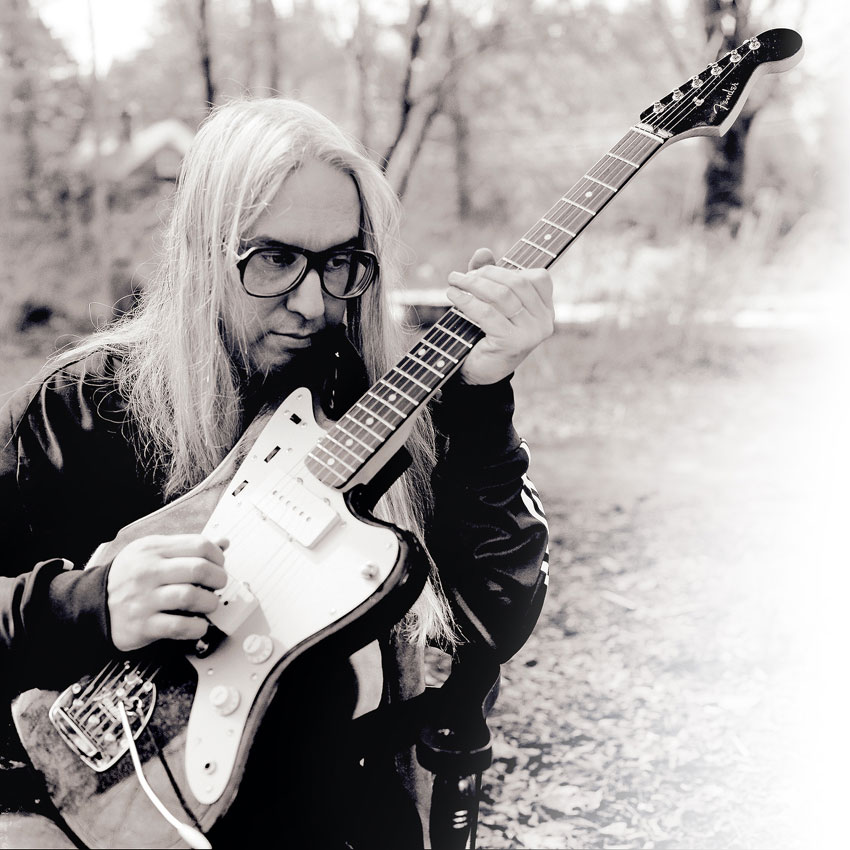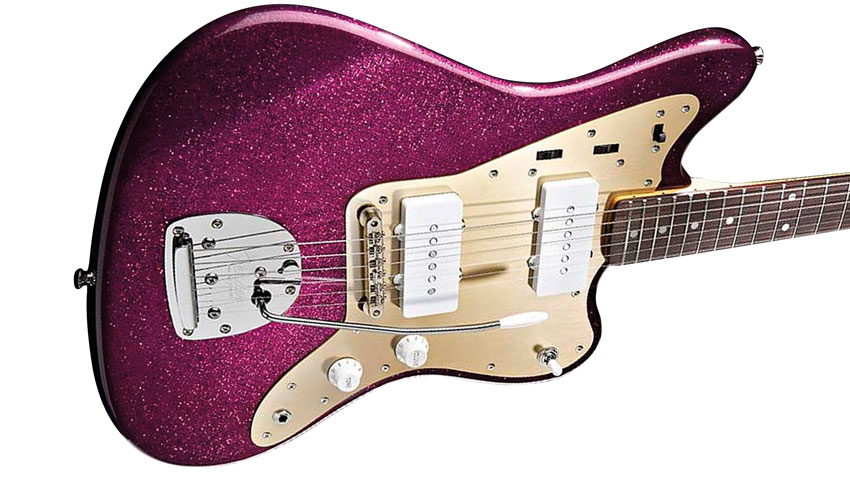Interview: J Mascis on Fender Jazzmasters, fuzz pedals and I Bet On Sky
Dinosaur Jr's frontman talks tone and gear-hoarding

Dinosaur Jr's enigmatic frontman J Mascis is behind some of the most thrillingly cool, creative (and plain loud) alt-rock guitar ever recorded. Here, he tells us all about his long-term love for Fender's Jazzmaster, chaining together vintage fuzz pedals for giant tone - and recording the band's superb new album, 'I Bet On Sky'...
It's refreshing to learn that even alt-rock icons face DIY challenges like the rest of us. When we called J Mascis at home to discuss Dinosaur Jr's new album, I Bet On Sky, a family member answers and says J is outside attempting to attach a roof rack to his car - and that things are not going wholly according to plan.
"Nobody liked us in our town - New York was the first place we kind of felt accepted at all."
The reluctant roof rack tells its own story, however, as it's being fitted in preparation for a quick holiday before J departs on a lengthy tour with the new album. Dinosaur Jr have undoubtedly come a long way since their early days in Amherst, Massachusetts. There, as noisy upstarts in the mid-80s, few knew what to make of their heavy but brilliantly original sound.
"Nobody liked us in our town," J recalls. "We'd even go to Boston and people didn't like us - New York was the first place we kind of felt accepted at all."
Once Dinosaur Jr ventured to the Big Apple, however, they found admirers in Sonic Youth, the hugely influential post- punk outfit who boasted the eviscerating distortion sounds of Thurston Moore on guitar - then at the peak of his powers.
"It was great because we were really floundering around and Sonic Youth was a band we liked," J reflects, in his trademark treacle-slow, deadpan drawl. "It was awesome that they were supportive of us,they took us on their first tour and helped us out a lot."
With cult and then mainstream recognition following in the wake of seminal early albums such as Dinosaur and You're Living All Over Me, the band's power-trio line-up featured J Mascis on guitar, Lou Barlow on bass and Murph (full name Emmett Jefferson Murphy III) on drums.
Get the MusicRadar Newsletter
Want all the hottest music and gear news, reviews, deals, features and more, direct to your inbox? Sign up here.
Rather like The Beach Boys singing close harmony through a loudhailer, the band's style mixed delicate, almost frail vocal melodies with bludgeoning electric tones courtesy of a then-unpopular Fender electric, the Jazzmaster.
Dinosaur Jr's latest album doesn't completely depart from the wall-of-fuzz sound that Mascis is best known for, but he gave himself free reign to use new sounds and instruments if the songs required it, rather than worry too much about how it would translate to the stage.
"We did the recording at my house here in Amherst and it seemed to go fairly smooth, as albums go. I was just kind of trying to realise every song that came up," he says. "I guess I wasn't as worried about playing it live.
"On I Bet On Sky I used a '58 Tele a lot for leads and different things for rhythm like a Les Paul Junior"
"The last two albums I was thinking more about playing the stuff live and this one, I didn't worry about it. If I wanted to put some keyboard in that would never get played live or something, I just did." Mascis adds that the palette of guitar tones used on I Bet On Sky was quite a bit broader than in the band's early work.
"I used a '58 Tele a lot for leads and different things for rhythm like a Les Paul Junior - a bunch of guitars. Basically, P-90s for rhythm, and I used this Tonebender copy that Jim [Roth] from the band Built To Spill made. I used that on a lot of lead tracks usually combined with some other fuzz."
We mention that the woody, sweet fuzz tone on the new album's standout track Almost Fare was particularly chewy. Did that tone arrive courtesy of the Tonebender clone, too?
"Yeah, that's probably that one and maybe a [Univox] Super-Fuzz together. I was using the Tonebender on most tracks, then adding different fuzzes with it - sometimes three, usually just two."

We ask if J is much of a collector, given that his sound seems rooted in classic Fender guitar sounds voiced through big, vintage-style fuzz. Does he set much store in the sonic mystique of old instruments?
"I don't know how many guitars I've got but I do prefer old ones. I don't want to pay top dollar, I just want the sound"
"Yeah, I have a lot of stuff - I'm always drowning in stuff," Mascis replies, a touch ruefully. "I don't know how many guitars I've got but I do prefer old ones. I get a lot of refinished guitars; I don't want to pay like top dollar, I just want the sound, so usually so I'll buy a lot of refinished ones where the headstock's been cracked or something but they still have the sound, but they're a little bit cheaper."
Amp-wise, Mascis turned to classic British and American combos to provide the thunderous tones that are such a powerful feature of I Bet On Sky. "I used a '59 Vox AC15 and a [Fender] Tweed Deluxe and a Tweed Bandmaster," he explains.
So, why is it that in all of the (incredibly loud) live Dinosaur Jr performances we've seen, he opts for imposing Marshall stacks instead of these old-school combos? "It seemed to work at Woodstock - so I figured why wouldn't it work today?" he replies, matter of factly. At this point, we can't resist asking how J's hearing is holding up after some three decades of this mighty sonic onslaught?
"Ah - I'm not sure," he replies after a pause for reflection. "I mean my ears ring a lot but I've always worn earplugs. It still rattles your bones, though, and everybody likes the sound. I don't know, it's gotten weird: a lot of sounds seem to be done at the desk these days. I've seen bands with no cabinets on stage, just ear monitors and roadies turning the knobs on the amps."
We venture that there's still no substitute for getting air moving at source when it comes to stellar live tone...
"I write either with an electric unplugged or with an acoustic"
"That's the kind of guitar sound I always thought sounded good, so why should it be different now?" he concurs.
Given the glorious wildness of Mascis' amplified tone, how does he like to write his songs? Does he find inspiration in practising at the searingly high volume of his live shows - or just sitting quietly with an acoustic?
"Oh yeah, I write either with an electric unplugged or with an acoustic," Mascis says. "Kinda like semi-hollowbody electric is my preferred volume for writing. You know, like watching TV and playing on the guitar."
And what about the strange and wonderful collisions of words that form Dinosaur Jr's lyrics? Are they totally spur of the moment, or the product of meticulous writing?
"I do them pretty fast - the night before I sing it or something. And then when I'm singing I'll rewrite it, too, if it just sounds weird. It's hard to tell, unless you're singing if something sounds stupid or you can pull it off or whatever," Mascis explains.
"A lot of lines I'll rewrite while I'm singing it. It's gotta sound right because the melody's already there in the song and the words have to kind of fit in - and then you have to believe what you're singing. If it sounds too stupid it's hard to sing," he adds.
At this point the noise of children stampeding by at the Mascis end of the line momentarily interrupts the interview. After resuming for a few more questions, which receive polite but brief answers from Mascis, we come - with a gentle bump - to the end of our allotted slot.
Like his music, Mascis comes across as disarmingly open and sincere - yet strangely elusive for all that. As for the album itself, it's gratifying to hear such a warm, intense and heavyweight guitar tone used as the vehicle for sublime songwriting.
And while we hope he got his car sorted in time for that well-deserved holiday, we're pretty sure auto-repair's loss is guitar music's gain.
Alright, Squier? J Mascis on Jazzmasters

J Mascis is one of the select band of Fender endorsees who has not one but two signature models. The original Purple Sparkle-finish Fender model was a beauty, so we asked him what inspired the re-imagined Squier version...
"People first thought it was weird playing distorted music with a Jazzmaster because they only thought of surf"
"The Jazzmaster is just the first guitar I really had, and I learned how to play on it," Mascis explains. "I kind of built my sound around it. So I'm just used to it, I guess. Now when I hear it against other guitars like a Strat it sounds like it has a little bit more. It's not as trebly or thin.
"People first thought it was weird playing distorted music with a Jazzmaster because they only thought of surf and stuff with them. But by now it's become pretty accepted that they can make a lot of noise also."
"First I had the Fender [signature model] but still I always wanted something cheap that people could buy," Mascis explains.
"The Fender one started out at like $900 and they kept raising it and suddenly it was like $1,200 or something and so I was interested in the Squier and finally persuaded them to let me do a Squier one. So it's under $400 but it seems pretty well built, you know? I've been playing it, too - it's pretty cool."
Jamie Dickson is Editor-in-Chief of Guitarist magazine, Britain's best-selling and longest-running monthly for guitar players. He started his career at the Daily Telegraph in London, where his first assignment was interviewing blue-eyed soul legend Robert Palmer, going on to become a full-time author on music, writing for benchmark references such as 1001 Albums You Must Hear Before You Die and Dorling Kindersley's How To Play Guitar Step By Step. He joined Guitarist in 2011 and since then it has been his privilege to interview everyone from B.B. King to St. Vincent for Guitarist's readers, while sharing insights into scores of historic guitars, from Rory Gallagher's '61 Strat to the first Martin D-28 ever made.
“Every note counts and fits perfectly”: Kirk Hammett names his best Metallica solo – and no, it’s not One or Master Of Puppets
“I can write anything... Just tell me what you want. You want death metal in C? Okay, here it is. A little country and western? Reggae, blues, whatever”: Yngwie Malmsteen on classical epiphanies, modern art and why he embraces the cliff edge












